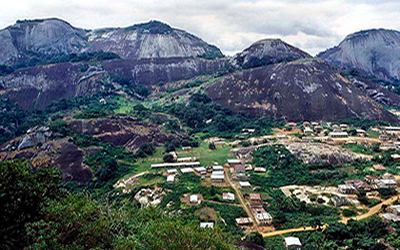Idanre: 660 steps to wonder hill (Punch)

Idanre Is a sleepy town of about 129,000 people located beautifully at a valley spanning 1,914 square kilometres. For a first time visitor, the visibly striking features of the range of mountains with several peaks along the undulating expanse set the stage for an excellent experience with nature. However, the people are seemingly oblivious of the intimidating heights of rocks encircling them in a conical order, as they go about their daily activities ignoring the awesome natural edifices. People in Idanre are largely farmers. This differs from what is common in other climes, where the location of a tourist’s site defines the occupation and vocation of the population around that location. As one drives into the town, the tarred road is halved by cocoa seeds. Most farmers have turned a part of the road into sun-baked ground. It is difficult to perceive any tourism indicators at the entrance to the town, which is home to some interesting ancient histories worth selling to the world. “The town can be described as a close locked up by the heights of mountains. There is only one road leading into the town. It is the same road that you will pass through if you are leaving the town,” a visitor, who craved anonymity, said.
SUNDAY PUNCH learnt that during the pre-colonial era, some of the indigenes had lived on top of the Idanre hill, known among the people as Oke Idanre. A tour guide with the Ondo State Tourism Office, who wished to be identified simply as Richard, said, “In the past, the Idanre people lived on top of the hill, which offered a plateau-like environment, and served as home to the various ancient Idanre communities. It also provided a ready protection for the people against invading armies. The people lived on the hill for 800 years before the quest for development forced them down to the valley in 1928.” The hill’s flat surface is 3,000 feet above sea level. It is accessible by an intimidating 660 steps laid in concrete along the side of the hill. Climbers are furnished with several resting places to make climbing a pleasurable adventure. Richard also said, “The steps were 460 in number when it was first constructed in 1954, but with the intervention of UNESCO in 2007, when the hill was tentatively listed as a world heritage site, the steps went up to 660. The ancient community of Oke Idanre are in three quarters, occupying a land area of 5km radius.”

Idanre hill still retains the Old Igboore Standard School, located in the first part of the hill, known as Udega, established in 1896 by Gilbert Carter, who was a colonial visitor to Nigeria in 1894. It also boasts of the legendary Omiapaara (Thunder River), the Arun River, supposedly possessing healing powers; the court, and the mausoleum, where kings were interred. Although the practice of burying dead kings on the hill is no longer in vogue, the Idanre still bring their dead traditional rulers up the hill to perform the last funeral rites on them before they are finally interred. An interesting feature of the hill is the inscription on one of the gigantic rocks, similar to ancient hieroglyphics. The letters are clear, but unintelligible and unreadable: a perpetual mythical mystery in the midst of the mountain jungle. Richard said, “The letters had been so designated because no one has been able to read them.” Another notable site on the hill is the ancient palace. The inner court of the palace is beautifully decorated by sculptural carvings used as pillars along the length and breadth of the court. The carvings, which depict the loyal servants of the ruling kings at different times, are in dire need of renovations and preservation. However, the tour guide said the architectural design of the ancient palace had been adopted in the construction of the new palace down the valley. This could be confirmed by an aerial view of the new palace from the top of the hill. At the courtyard are some dried skulls of cattle slaughtered every year to commemorate the anniversary of the Idanre king. The number of skulls represented the number of years a particular king had spent on the throne. “This place still holds great cultural value to the people of Idanre. Any time they want to perfect certain cultural rights, either during festivals or coronation of chiefs, the Idanre people will ascend the top of the hill and return to their ancient home,” the guide said.
The Orosun festival is a notable one associated with the hill. The Mare festival is a recent creation which is sports oriented and involves mountain climbing. Idanre is no doubt an exciting tourist site, with a potential to compete with other national and international tourist attractions across the world. The historical sites still present there underline this. However, it seems not enough attention and appreciation has been paid to Idanre Hill’s tourism potential. The tourism officer in charge of the site, Mr. I. Idowu, said the site lacked the basic infrastructure befitting a tourism destination. According to him, lack of perimeter fencing and a welcoming facade reduces its value as a tourism site. “Whenever we have a large number of people coming in, the community benefits because the people buy beverages from them. We are supposed to have accommodation, restaurant, bar and a car park. Then we can do a good publicity for Idanre Hill. But these are lacking for now,” he said. Idowu’s lamentations are evident in the dilapidated chalets, poorly kept surroundings and littered environment on the hill.
Idanre Hill, which was tentatively listed as a world heritage site by UNESCO in 2007, is not living up to its rating, writesOLUWOLE JOSIAH













